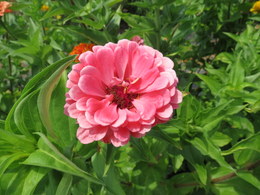Zinnia Growing Guide
Zinnia (Zinnia spp.) is an annual wildflower native to southwestern United States, Mexico to Central America. They are in the Daisy family and have large flowers that appear in midsummer through fall. Its flowers come in red, orange, yellow, pink and white.
Most common are Zinnia elegans which can range in height 12 to 48-inches tall. The blooms can be single, semi-double or fully double.
The single petaled blooms have a visible center that easily attracts butterflies, hummingbirds and pollinators.
The semi-double petaled blooms still have a visible center, but have several rows of petals.
The double petaled blooms do not have a visible center, but have many rows of petals that have a very full thick appearance.
Zinnia angustifolia also called creeping zinnia, have a narrow leaf with a bushy appearance growing 8 to 16-inches tall. These make good border plants in front of taller plants and will produce flowers up until the first hard frost in the fall.
In addition to being deer resistant they are a nectar plant for butterflies and pollinators.
Starting From Seed
Zinnias can be started indoors 6 to 8-weeks before your last expected frost date. They do not transplant well and can be started in Jiffy peat pellets or 3 to 4-inch biodegradable peat pots. You can then plant the entire pellet or pot without disturbing the roots which causes transplant shock.
By starting them this way, you can plant them spaced in your flower garden in a very orderly manner.
You can direct sow zinnias in your flower garden in the late spring to early summer. Cover with 1/4-inch of soil followed by frequent light watering to keep the soil from drying out. A large mass planting makes an impressive display.
To extend the flowering period you can sow more seeds every week or two.
Thin as directed on the seed packet. For more guidance our seed starting page will be helpful.
Soil Preparation
Plant your zinnias in full sun in a nice loose well-drained garden soil. As soon as the soil is frost-free and can be worked, till the soil by digging down 8 to 12-inches turning the soil over with a garden fork, removing any large rocks. The small pebbles remaining will do no harm and actually benefit the soil by adding some micronutrients to the soil. Zinnias will do best in a slightly acid soil with a pH range of 5.5 to 7.0.
When to Plant
Zinnias should be planted in the late spring after the last expected frost and the soil warms up.
Planting Zinnias
Refer to the plant tag or seed packet instructions. In general, plant zinnias 4 to 24-inches apart, depending on the variety, in groups of 3 or 5 behind other shorter plants. Dig a hole as deep as the pot and twice as wide. To the soil you just removed add the same amount of good garden soil so you have a nice blend of new and native soil.
Place the zinnia in the hole even with or an inch higher than the surrounding soil. Gently back fill the hole around the zinnia leaving a shallow depression around your plants. Fill the depression with water to settle the soil around the roots adding more soil if necessary and water again. Water daily tapering off as the zinnia gets established.
Watering and Care
Zinnias are low maintenance and easy to care for. All you need to do is add a layer of mulch to help retain moisture and keep out competing weeds. Your zinnias should get an inch of water each week and during dry spells give some water to keep the soil moist.
They usually do not need any fertilizer, but a light side dressing of organic fertilizer such as Espoma Flower-tone can be placed around the plant in the spring.
Remove spent flowers to promote additional blooms and maintain plant appearance.
Diseases and Pests
Zinnias are susceptible to powdery mildew. The best way to prevent powdery mildew is good air circulation and watering at the roots, keeping water off of the leaves. Good organic controls are products such as Bonide neem oil and Bonide copper fungicide.
Both are certified for organic use on a wide variety of outdoor and indoor plants right up to the day before harvest.
Zinnias do not have any major insect problems, but if Japanese beetles are found, hand picking them is an effective way to control the damage they may do. An easy way to remove them is to hold a bucket or jar of soapy water under the Japanese beetle and shake the plant. This usually causes them to drop into the soapy water. A reusable trap such as Tanglefoot Japanese Beetle Trap can be used to catch the adults.
Milky Spore is a naturally occurring microscopic bacteria (Bacillus popilliae) that is safe for people and pets. It kills Japanese beetle grubs in the soil before they can emerge and damage your plants. It is applied to your lawn where it reaches peak effectiveness in three years.
Popular Varieties
Dwarf varieties 8 to 12-inches tall include the Dasher, Dreamland, Fantastic, Lollipop, Magellan, Thumbelina.
Medium varieties usually to about 20 inches tall include the Zahara, Profusion and Mexican series.
Tall varieties reaching up to 36 to 48-inches tall include Benary’s Giant, Giant Cactus, State Fair, Peppermint Stick, Queen Red Lime, Uproar Rose.
Sources: Burpee, Eden Brothers, Park Seed.
Gardening thought:
“I must have flowers, always and always.” – Claude Monet
Garden Spikes newsletters give you timely information once or twice a month. Subscribe Free to the Garden Times newsletter below.
Your email address will only be used to send you a newsletter and will never be sold. You can unsubscribe at any time.

